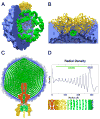Nucleic acid packaging in viruses
- PMID: 22277169
- PMCID: PMC3288730
- DOI: 10.1016/j.sbi.2011.11.002
Nucleic acid packaging in viruses
Abstract
We review recent literature describing protein nucleic acid interactions and nucleic acid organization in viruses. The nature of the viral genome determines its overall organization and its interactions with the capsid protein. Genomes composed of single strand (ss) RNA and DNA are highly flexible and, in some cases, adapt to the symmetry of the particle-forming protein to show repeated, sequence independent, nucleoprotein interactions. Genomes composed of double-stranded (ds) DNA do not interact strongly with the container due to their intrinsic stiffness, but form well-organized layers in virions. Assembly of virions with ssDNA and ssRNA genomes usually occurs through a cooperative condensation of the protein and genome, while dsDNA viruses usually pump the genome into a preformed capsid with a strong, virally encoded, molecular motor complex. We present data that suggest the packing density of ss genomes and ds genomes are comparable, but the latter exhibit far higher pressures due to their stiffness.
Copyright © 2011 Elsevier Ltd. All rights reserved.
Figures

Similar articles
-
The Effects of Packaged, but Misguided, Single-Stranded DNA Genomes Are Transmitted to the Outer Surface of the ϕX174 Capsid.J Virol. 2021 Aug 25;95(18):e0088321. doi: 10.1128/JVI.00883-21. Epub 2021 Aug 25. J Virol. 2021. PMID: 34232738 Free PMC article.
-
Networks of evolutionary interactions underlying the polyphyletic origin of ssDNA viruses.Curr Opin Virol. 2013 Oct;3(5):578-86. doi: 10.1016/j.coviro.2013.06.010. Epub 2013 Jul 10. Curr Opin Virol. 2013. PMID: 23850154 Review.
-
Viral genome organization.Adv Protein Chem. 2003;64:219-58. doi: 10.1016/s0065-3233(03)01006-4. Adv Protein Chem. 2003. PMID: 13677049 Review. No abstract available.
-
Packaging in dsRNA viruses.Adv Exp Med Biol. 2012;726:601-8. doi: 10.1007/978-1-4614-0980-9_26. Adv Exp Med Biol. 2012. PMID: 22297532 Review.
-
[Genome-linked proteins in DNA and RNA viruses].Mol Biol (Mosk). 1987 Jul-Aug;21(4):876-81. Mol Biol (Mosk). 1987. PMID: 3309620 Review. Russian.
Cited by
-
A Customized Novel Blocking ELISA for Detection of Bat-Origin Swine Acute Diarrhea Syndrome Coronavirus Infection.Microbiol Spectr. 2023 Aug 17;11(4):e0393022. doi: 10.1128/spectrum.03930-22. Epub 2023 Jun 5. Microbiol Spectr. 2023. PMID: 37272819 Free PMC article.
-
Capsid Structure of Leishmania RNA Virus 1.J Virol. 2021 Jan 13;95(3):e01957-20. doi: 10.1128/JVI.01957-20. Print 2021 Jan 13. J Virol. 2021. PMID: 33208443 Free PMC article.
-
Finite particle size drives defect-mediated domain structures in strongly confined colloidal liquid crystals.Nat Commun. 2016 Jun 29;7:12112. doi: 10.1038/ncomms12112. Nat Commun. 2016. PMID: 27353002 Free PMC article.
-
Functional Dissection of a Viral DNA Packaging Machine's Walker B Motif.J Mol Biol. 2019 Nov 8;431(22):4455-4474. doi: 10.1016/j.jmb.2019.08.012. Epub 2019 Aug 30. J Mol Biol. 2019. PMID: 31473160 Free PMC article.
-
Finally, a Role Befitting Astar: Strongly Conserved, Unessential Microvirus A* Proteins Ensure the Product Fidelity of Packaging Reactions.J Virol. 2020 Jan 6;94(2):e01593-19. doi: 10.1128/JVI.01593-19. Print 2020 Jan 6. J Virol. 2020. PMID: 31666371 Free PMC article.
References
-
- Schneemann A. The structural and functional role of RNA in icosahedral virus assembly. Annu Rev Microbiol. 2006;60:51–67. - PubMed
-
- Speir JA, Johnson JE. Virus Particle Structure: Nonenveloped Viruses. In: Mahy BWJ, van Regenmortel MHV, editors. Encyclopedia of Virology. Third. Elsevier; 2008. pp. 380–393.
-
- Tewary SK, Oda T, Kendall A, Bian W, Stubbs G, Wong SM, Swaminathan K. Structure of hibiscus latent singapore virus by fiber diffraction: a nonconserved his122 contributes to coat protein stability. J Mol Biol. 2011;406:516–526. - PubMed
-
- Tawar RG, Duquerroy S, Vonrhein C, Varela PF, Damier-Piolle L, Castagne N, MacLellan K, Bedouelle H, Bricogne G, Bhella D, et al. Crystal structure of a nucleocapsid-like nucleoprotein-RNA complex of respiratory syncytial virus. Science. 2009;326:1279–1283. The authors combine x-ray and cryoEM structure determination methods to elucidate the complete RSV nucleocapsid helical structure. This provides a model, based on alternating exposed and buried nucleotide bases, for readout of the highly sequestered genome by the viral polymerase. - PubMed
-
- Green TJ, Rowse M, Tsao J, Kang J, Ge P, Zhou ZH, Luo M. Access to RNA encapsidated in the nucleocapsid of vesicular stomatitis virus. J Virol. 2011;85:2714–2722. Contrary to previous reports, the authors show that (-)ssRNA in the VSV nucleocapsid can be digested away by RNase. The N protein still assembles to form empty capsids, which can bind a variety of polyribonucleotides. - PMC - PubMed
Publication types
MeSH terms
Substances
Grants and funding
LinkOut - more resources
Full Text Sources
Other Literature Sources

